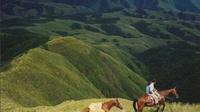Tafí del Valle and Quilmes Ruins Full-Day Tour from Tucumán
San Miguel de Tucuman, Argentina
Trip Type: Day Trips
Duration: 10 hours
The Diaguita Indians called Tafí del Valle “the town of the magnificent entrance” and they were right: Tafí del Valle is one of the most heavenly destinations in Tucumán. Once people get to this summertime villa, the valleys welcome their visitors with their green and brown colors that contrast with the blue sky, with a dike over which the sun reflects and with unpaved roads that are a testimony of years of history. A must do when visiting San Miguel de Tucumán.
More About This Activity All Day Trips →
The Diaguita Indians called Tafí del Valle “the town of the magnificent entrance” and they were right: Tafí del Valle is one of the most heavenly destinations in Tucumán. Once people get to this summertime villa, the valleys welcome their visitors with their green and brown colors that contrast with the blue sky, with a dike over which the sun reflects and with unpaved roads that are a testimony of years of history. A must do when visiting San Miguel de Tucumán.At 107km away from the capital, Tafí is located at 2000 meters above the sea level. It has a very pleasant climate, which allows for tourism all year long. Once you get to Quilmes Ruins, the landscape of mountains and the Calchaquí cordon amazes the visitor and speaks for itself, though it is hard to imagine that in 800 DC, the Quilmes tribe lived there, in one of the most important pre-Hispanic settlements of the Calchaquí groups.
Leave Tucumán behind and start ascending the valley through the Route 307. The road goes into the Los Sosa River Gorge, part of the Natural Reserve with the same name. Continuing, we will sight the monument "El Indio".
Higher, the entrance to the Valley of Tafi is simply shocking. Surrounding La Angostura Dam we will arrive at The Mollar to visit The Menhires. It only takes a walk along the Archaeological Reserve Los Menhires and a look at the 50 types of rocks dating from more than 2000 years (from the beginning of the Christian era)- that rise up to 3 meters high- to be amazed by the archaeological legacy of the primitive races.
The word menhir has a Celtic origin and it means “long stone”. The shapes represented in the mehnirs are surprising: sometimes they show human faces and other times animal faces, mainly felines. Others are geometric and there also are combinations of different types.
Later we will visit the picturesque city of Tafi del Valle. Inside Tafí del Valle, the Jesuit architecture is preserved, the oldest section was built by the Jesuits in the first half of the eighteenth century. In the valley we will have free time for lunch (optional) an then we continue through the Route 307 up to the viewpoint from which the best views of the valley are obtained, in a pronounced zigzag until Abra del Infiernillo , at 3,042 meters high.
In Amaicha del Vallewe will visit the square and its surroundings. After connecting with the 40 National Route, the Sacred City of Quilmes breaks left. The visitor will be able to tour the complex with the company of a guide and will be amazed to know every detail of the last bastion on aboriginal resistance against the Spanish advance, that finished in 1667, when 1700 survivors were sent, walking, to the proximity of Buenos Aires (currently the city of Quilmes), where only 400 of them made it there. The Museo del Sitio (currently out of service for restoration) showcases pieces obtained in the excavations and invites you to dive into an unprecedented legacy.
The return includes hotel drop-off in Tucumán.
Leave Tucumán behind and start ascending the valley through the Route 307. The road goes into the Los Sosa River Gorge, part of the Natural Reserve with the same name. Continuing, we will sight the monument "El Indio".
Higher, the entrance to the Valley of Tafi is simply shocking. Surrounding La Angostura Dam we will arrive at The Mollar to visit The Menhires. It only takes a walk along the Archaeological Reserve Los Menhires and a look at the 50 types of rocks dating from more than 2000 years (from the beginning of the Christian era)- that rise up to 3 meters high- to be amazed by the archaeological legacy of the primitive races.
The word menhir has a Celtic origin and it means “long stone”. The shapes represented in the mehnirs are surprising: sometimes they show human faces and other times animal faces, mainly felines. Others are geometric and there also are combinations of different types.
Later we will visit the picturesque city of Tafi del Valle. Inside Tafí del Valle, the Jesuit architecture is preserved, the oldest section was built by the Jesuits in the first half of the eighteenth century. In the valley we will have free time for lunch (optional) an then we continue through the Route 307 up to the viewpoint from which the best views of the valley are obtained, in a pronounced zigzag until Abra del Infiernillo , at 3,042 meters high.
In Amaicha del Vallewe will visit the square and its surroundings. After connecting with the 40 National Route, the Sacred City of Quilmes breaks left. The visitor will be able to tour the complex with the company of a guide and will be amazed to know every detail of the last bastion on aboriginal resistance against the Spanish advance, that finished in 1667, when 1700 survivors were sent, walking, to the proximity of Buenos Aires (currently the city of Quilmes), where only 400 of them made it there. The Museo del Sitio (currently out of service for restoration) showcases pieces obtained in the excavations and invites you to dive into an unprecedented legacy.
The return includes hotel drop-off in Tucumán.
« Go Back

